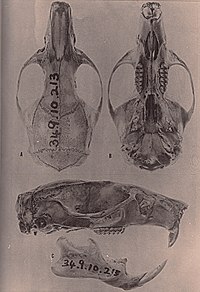25:
44:
244:
Steppan, S.J. 1995. Revision of the tribe
Phyllotini (Rodentia: Sigmodontinae), with a phylogenetic hypothesis for the Sigmodontinae. Fieldiana Zoology 80:1–112.
249:
Phylogenetic relationships of oryzomyine rodents (Muroidea: Sigmodontinae): separate and combined analyses of morphological and molecular data
76:, defined by the position of the cutting edge of the incisor relative to the vertical plane of the incisors.
264:
190:
172:
160:
166:
43:
184:
178:
31:
97:
50:
258:
126:
120:
24:
155:
144:
108:
103:
114:
150:
138:
132:
73:
118:
are orthodont and have sometimes even been described as proodont, and
65:
248:
154:, formerly classified as phyllotines, are also hyper-opisthodont.
84:) incisors have the cutting edge in front of the vertical plane,
251:. Bulletin of the American Museum of Natural History 296:1–149.
96:
teeth have the cutting edge even behind the back of the
8:
16:Orientation of the upper incisor in rodents
88:teeth have it perpendicular to the plane,
202:
92:incisors have it behind the plane, and
72:refers to the orientation of the upper
210:
208:
206:
7:
14:
158:are also mostly opisthodont, but
57:) has opisthodont upper incisors.
42:
23:
1:
223:Steppan, 1995, pp. 16–17
35:has orthodont upper incisors.
106:are mostly opisthodont, but
281:
232:Steppan, 1995, p. 18
214:Weksler, 2006, p. 43
191:Sigmodontomys aphrastus
136:are hyper-opisthodont.
130:, and some species of
173:Melanomys caliginosus
161:Amphinectomys savamis
167:Handleyomys fuscatus
70:incisor procumbency
247:Weksler, M. 2006.
55:Oryzomys palustris
185:Scolomys melanops
179:Mindomys hammondi
94:hyper-opisthodont
32:Mindomys hammondi
272:
239:Literature cited
233:
230:
224:
221:
215:
212:
100:of the incisor.
46:
27:
280:
279:
275:
274:
273:
271:
270:
269:
255:
254:
241:
236:
231:
227:
222:
218:
213:
204:
200:
194:are orthodont.
62:
61:
60:
59:
58:
47:
38:
37:
36:
28:
17:
12:
11:
5:
278:
276:
268:
267:
265:Rodent anatomy
257:
256:
253:
252:
245:
240:
237:
235:
234:
225:
216:
201:
199:
196:
51:marsh rice rat
48:
41:
40:
39:
29:
22:
21:
20:
19:
18:
15:
13:
10:
9:
6:
4:
3:
2:
277:
266:
263:
262:
260:
250:
246:
243:
242:
238:
229:
226:
220:
217:
211:
209:
207:
203:
197:
195:
193:
192:
187:
186:
181:
180:
175:
174:
169:
168:
163:
162:
157:
153:
152:
147:
146:
141:
140:
135:
134:
129:
128:
123:
122:
117:
116:
111:
110:
105:
101:
99:
95:
91:
87:
83:
79:
75:
71:
67:
56:
52:
45:
34:
33:
26:
228:
219:
189:
183:
177:
171:
165:
159:
149:
143:
137:
131:
127:Loxodontomys
125:
121:Eligmodontia
119:
113:
107:
102:
93:
89:
85:
81:
77:
69:
63:
54:
30:
90:opisthodont
198:References
156:Oryzomyini
145:Reithrodon
109:Auliscomys
104:Phyllotini
82:procumbent
115:Galenomys
86:orthodont
259:Category
151:Neotomys
139:Irenomys
98:alveolus
78:Proodont
133:Calomys
74:incisor
66:rodents
188:, and
148:, and
112:and
80:(or
49:The
64:In
261::
205:^
182:,
176:,
170:,
164:,
142:,
124:,
68:,
53:(
Text is available under the Creative Commons Attribution-ShareAlike License. Additional terms may apply.

